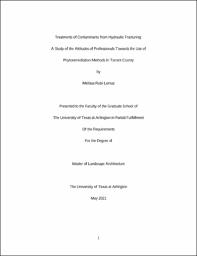| dc.description.abstract | Hydraulic fracturing poses challenges to the environmental stability of the areas surrounding a hydraulic fracturing site due to exposure to the byproducts of the hydraulic fracturing process. (Rahm, 2011; Perry, Sutton, Guo, Yan, & Yang, 2018; Gómez-Sagasti et al., 2012; Richardson et al., 2015). The use of hydraulic fracturing has increased in the United States, notably in North Texas. As the population of the DFW metroplex increases, oil and natural gas companies have begun to construct hydraulic fracturing sites within neighborhoods in the urban setting (Rahm, 2011). As the number of wells created in the urban setting continues to increase, efforts are being made nationwide to discover ecological and minimally invasive methods to treat the toxic byproducts of the fracturing process, such as phytoremediation and phytotechnology.
Phytoremediation and phytotechnology methods are currently used to treat polluted soils and water in mining and sites with heavy metal usage and are also subject for research as methods for treating the contaminants left behind by the hydraulic fracturing process (Perry, Sutton, Guo, Yan, & Yang, 2018). Phytoremediation has shown promise in delivering lower-cost remediation for sites that are considered to have low levels of contaminants. The type of methods used for phytotechnology and evidence that supports the use of indigenous and regionally based plant palettes can be customized according to the specific pollutants found in the flowback fluids and other industrial activities (Kennen & Kirkwood, 2017). However, it is a method that has not been extensively studied in the applications of hydraulic fracturing treatment within the state of Texas.
This research assesses the current attitudes of practicing professionals in Tarrant County of this method of remediation. Subjects of the study include implementation of phytotechnology methods to treat pollutants found in flowback fluids such as BTEX (Benzene, Toluene, Ethylbenzene, and Xylene), environmental and ecological benefits, and the feasibility of implementing regionally native plants. The study area will be limited to Tarrant County and will focus on the overlap of the Barnett Shale with the Tarrant County biome to study the potential of a regionally appropriate plant pallet. By discussing the current policy and regulations which exist in the state of Texas and in Tarrant County for the remediation of flowback fluid contaminants, a case is made for the importance of studying the implementation of phytotechnology treatments as a solution to treat the surrounding soil of hydraulic fracturing pads, the water found in flowback fluids, and the implementation of a regionally appropriate plant pallet. | |


